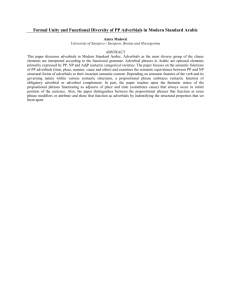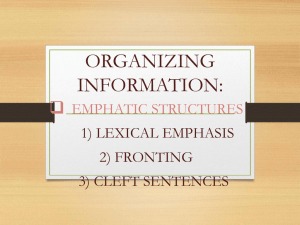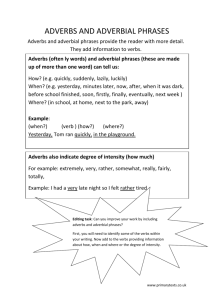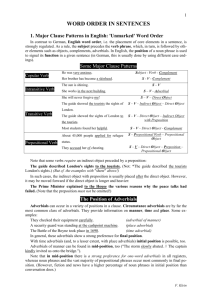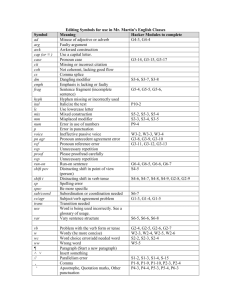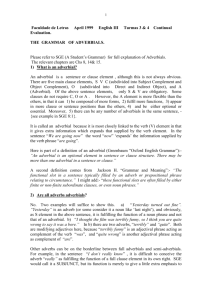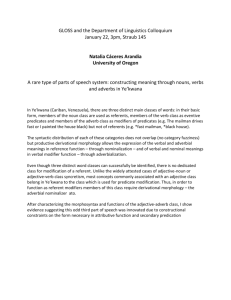The Structure of Adverbials - Linguistics
advertisement
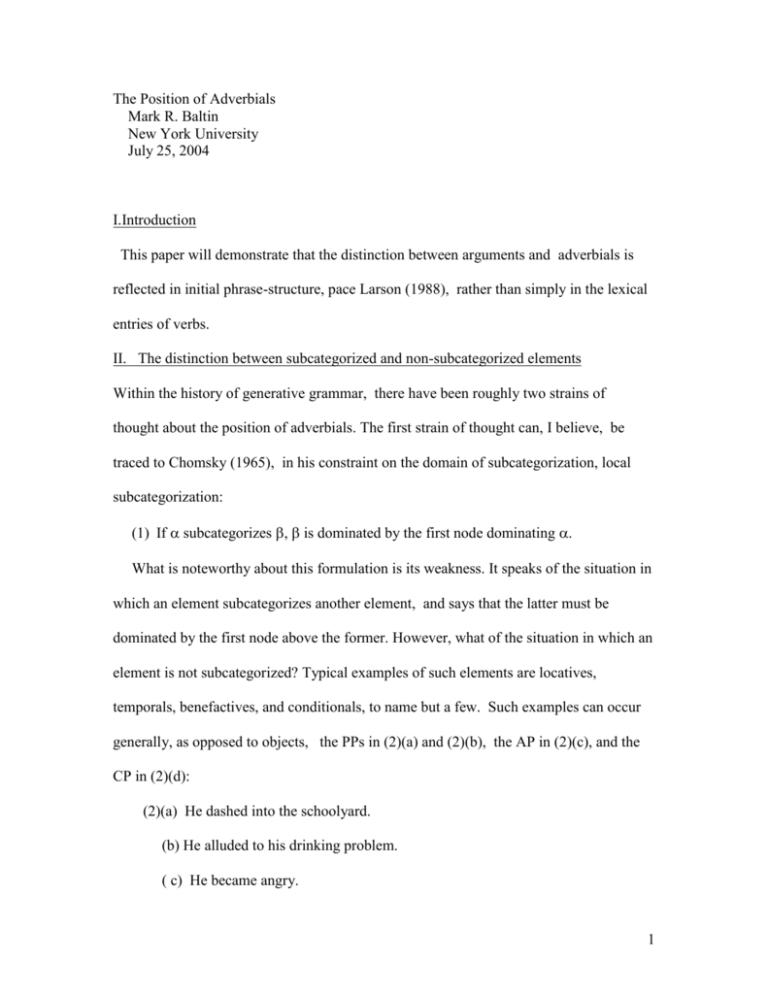
The Position of Adverbials Mark R. Baltin New York University July 25, 2004 I.Introduction This paper will demonstrate that the distinction between arguments and adverbials is reflected in initial phrase-structure, pace Larson (1988), rather than simply in the lexical entries of verbs. II. The distinction between subcategorized and non-subcategorized elements Within the history of generative grammar, there have been roughly two strains of thought about the position of adverbials. The first strain of thought can, I believe, be traced to Chomsky (1965), in his constraint on the domain of subcategorization, local subcategorization: (1) If subcategorizes , is dominated by the first node dominating . What is noteworthy about this formulation is its weakness. It speaks of the situation in which an element subcategorizes another element, and says that the latter must be dominated by the first node above the former. However, what of the situation in which an element is not subcategorized? Typical examples of such elements are locatives, temporals, benefactives, and conditionals, to name but a few. Such examples can occur generally, as opposed to objects, the PPs in (2)(a) and (2)(b), the AP in (2)(c), and the CP in (2)(d): (2)(a) He dashed into the schoolyard. (b) He alluded to his drinking problem. ( c) He became angry. 1 (d) He complained that he was hungry. Examples of non-subcategorized elements are underlined in (3): (3)(a) He visited Sally in Boston. (b) He visited Sally on her birthday. (c) He visited Sally for Susan. (d) He will visit Sally if John does. One school of thought has strengthened local subcategorization to a bi-conditional, as in (4): (4) is dominated by the first node dominating , an X0, if and only if subcategorizes . In other words, non-subcategorized elements, in the stronger view of local subcategorization, would have to be generated outside of a lexical head’s immediate projection. There are a number of possibilities: base-generating such elements as adjoined to some higher projection (Jackendoff (1977)), generating the elements as separate phrase-markers and adjoining them to a higher projection by a generalized transformation (Lebeaux (1988), Chomsky (1993), Fox (2002)), or generating such elements as specifiers of functional projections outside of the projection of a lexical head (Cinque (1999)). The second school of thought, exemplified best, I believe, by Larson (1988), allows such adverbials to be generated within the verb’s immediate projection, and would presumably distinguish these elements from internal arguments by some extraphrase-structural means, such as an absence of lexical specification in the verb’s lexical entry. He presents the thematic hierarchy in (5): 2 (5) Experiencer<Goal< Theme<Obliques With the adverbials under discussion being generated as obliques. The interpretation of this hierarchy is that if an element A outranks an element B on the hierarchy, A must be generated higher in the phrase-marker than B. For example, (6) would have the structure in (7): (6) John visited Sally on Tuesday. (7) CP C’ C TP T’ DP T Past vP DP John v’ v VP DP V’ Sally V visit PP on Tuesday. The main verb, visit in this case, will move to v. One argument that Larson gives for this approach is that it allows for coordinations such as the one in (8): (8) John visited Sally on Tuesday and Mary on Saturday. If we posited a structure in which the adverbial is adjoined, say to V’, as in (9), we would have to posit a coordination of non-constituents for (8), problematic on several grounds. By adopting the structure in (7), (8) becomes unproblematic, a simple 3 coordination of VPs, in which the verb visit will undergo across-the-board verb movement to v. Another argument against the adjoined structure for adverbials in (9)-indeed, more generally, against any argument in which the object is not higher in the phrase-marker than the adverbial-comes from considerations of binding, such as Principle A: (9) CP C’ C TP T’ DPi John T VP Past V’ DPi t V’ PP V D” visit Sally on Tuesday (10)Principle A: An anaphor must be bound in its local domain. The definition of binding is given in (11), and the definition of c-command in (12): (11) Binding=def. binds if and only if c-commands and and are coindexed. (12)C-command=def. c-commands if and only if does not dominate and the first node dominating dominates as well. 4 We can see, then, that the object must bind into the adverbial, and hence must ccommand it, by noting that an object can be the antecedent for an anaphor contained within the adverbial: (13)I visited the studentsi on each otheri’s birthdays. Similarly, a pronoun related to a quantifier must be c-commanded by the quantifier (Higginbotham (1980)), in order to be interpreted as a variable bound by the quantifier. Assuming that this is correct, we note that a pronoun within an adverbial can function as a variable bound by a quantified object: (14)I visited many prisonersi after theiri lawyers visited themi. Grammatical relationships that depend on c-command, then, would seem to favor a Larsonian structure such as (7) for adverbials rather than an adjoined structure such as (9), for it is within the former structure that objects c-command the adverbials, whereas they do not in the adjoined structure. Taken together with Larson’s analysis of coordinations of objects plus adverbials, we have a prima facie case for the structure in (7), in which adverbials are generated lower in the VP than objects. I will now show that there are other strong considerations that militate for structures in which the adverbials are outside of the VP. First, consider sentences such as (15): (15) I visited many studentsi after theiri lawyers did__. The structure for (5 (next page), assuming Larson’s structure, would be as in (16) (focusing only on the TP). In this case, the deleted VP, indicated as deleted by bolding, is contained within its antecedent. Unless some mechanism now gets the null VP out of its antecedent, this is a case of the much-discussed antecedent-contained 5 deletion (henceforth ACD) ( Bouton (1970), May (1985), Baltin (1987), Larson & May (1990), Fox (2002) and many others), and would lead to ungrammaticality if the null VP is allowed to remain within its antecedent, due to an infinite regress problem in determining its antecedent’s identity. In other words, if the interpretation of the null VP is obtained by copying the antecedent into the null VP, because the antecedent itself contains the null VP, one will have to keep copying the antecedent into the null VP in order to make the antecedent complete. Because the result of copying will always leave a null VP, the copying will never complete. (16) TP T’ T Past vP DP I v’ v VP DP Many prisonersi V’ V visit PP P TP after DP DP D’ T’ T theiri lawyers did vP e One influential view as to how to resolve the problem of antecedent-contained deletion (henceforth ACD) has invoked quantifier-raising at LF out of the antecedent VP 6 (May (1985)’s idea). One might reasonably take the subordinate clause ACD as being resolved by LF movement out of the antecedent, in which case the possibility of ACD here would tell us nothing about the overt position of the subordinate clause. Most examples of ACD have focused on relative clauses that contain the null VP, as in (17): (17) I ate everything you did___. There have been two main approaches to ACD in the literature: the LFevacuation approach, originally advocated in May (1985), which situates the null VP within its antecedent in the overt syntax, but removes it by an LF operation, Quantifier Raising, so that the null VP is not within its antecedent at LF; and the overt evacuation approach, advocated in Baltin (1987), in which the null VP is removed from its antecedent by an overt operation ( such as extraposition, as advocated in Baltin (1987)). It is clear that at least some cases of ACD would be straightforwardly resolved by placing the null VP outside of its antecedent in the first place. In this case, for instance, adverbial subordinate clauses are treated as nonquantificational modifiers in most standard semantics texts (Larson & Segal (1995), Heim & Kratzer (1998)). Hence, the QR approach is at least inconsistent with the semantic treatment of adverbial modifiers. We can still capture the fact that antecedent resolution in apparent ACD cases tracks scope by reading scope off of the overt syntactic structure. Fox and Nissenbaum, (2002), for example, note that ACD forces a de re reading of the subordinate clause when the matrix clause is included in the antecedent VP for the null VP in (18). (18) (Fox and Nissenbaum’s (3): 7 a. Room 1 wants to have dinner before Room 2 does < want to have dinner> b. Room 1 wants to have dinner before Room 2 does < have dinner>. As they note, (18)(a) has only the de re reading, while (18)(b) has the de dicto reading. However, we can simply posit one structure for the adverbial in which it is included within the matrix VP, forcing the de dicto reading, and another in which it is outside of it, yielding the de re reading. In this way, the adjunct is never contained within the VP to which it is adjoined, and its scope is read off of its adjunction position. In short, sentences such as (15) are interesting because they impose two apparently contradictory requirements. The variable-binding of the pronoun within the adverbial is forcing the adverbial to be lower than the object, while the ellipsis resolution of the null VP within the adverbial is forcing the adverbial to be outside of the VP. I would suggest that the contradiction is resolved by placing the adverbial outside of the VP, and moving the object to a position still higher than the adverbial. I will spell this out in Section IV, but before doing so, I would like to provide another piece of evidence that the adverbial is generated, and remains, outside of the VP. III.British English Do British English contains a type of VP-anaphora which looks,to all intents and purposes, like a variant of VP-ellipsis, so that (19)(a) and (19)(b) are, as far as I can determine, equivalent: (19)(a) John will read the book, and Fred will__, too. (b) John will read the book, and Fred will do, too. 8 However, there is a crucial difference between VP-ellipsis and British English do-anaphora. A VP-ellipsis gap, as is well-known (see, e.g., Hankamer & Sag (1976) and, for a recent lucid discussion of this issue, Johnson (2001)), exhibits internal structure, in the sense that it must house elements that would have originated in an overt phrasal counterpart of the gap. For example, VP-internal wh-phrases can appear within the gap: (20)Although I don’t know which book Fred will read, I do know which book Tom will[____t]. Also, an understood quantified object within the VP-ellipsis gap can take inverse scope over the subject, presumably by QR of the object over the subject: (21) Some man will read every book, and some woman will __too. (allows the understood every book to scope over some woman). Lasnik (1995) also provides evidence that internal arguments extract from an elided VP in the pseudo-gapping construction: (22)a. Although he didn’t give books to Sally, he did__magazines. b.Although he wouldn’t put books on the table, he would___on the mantlepiece. When we turn our attention to British English do-anaphora, however, we find a striking contrast. British English do does not tolerate any of the diagnostics for internal structure, so that wh-traces are impossible within the VP covered up by do. (23)* Although I don’t know which book Fred will read, I do know which book Tom will do. Inverse scope is impossible in the British English do construction: 9 (24)Some man will read every book, and some woman will do too. (can only be understood with the subject scoping over the object in both clauses.). The pseudo-gapping construction is impossible in the British English do construction: (25)*Although I won’t put the book on the table, I will do__on the mantelpiece. Given this, we would not want to derive British English do in the same way in which we derive the VP-ellipsis construction. The most natural account of the difference would be to derive VP-ellipsis by deletion of the VP after the relevant operations ( whmovement, QR, A-movement in the pseudo-gapping construction) occur, while British English do would really be a Pro- VP. For concreteness, let us follow Postal’s (1966) view of pronouns as determiners, and view British English do as v (or perhaps a lexical instantiation of Kratzer’s (1994) category Voice). In short, the overt pro-form is really a functional head, but perhaps a syntactically intransitive one, lacking a lexical complement in the syntax but having the semantic features of its typical complement in its lexical representation. Because the complement (in this case, a VP, but for typical pronouns, an NP) is not present syntactically, there would be no source for elements that would have to be generated within the complement. Hence, the structure of a clause with British English do will be as in (26): 10 (26) C” C’ C T” D” T’ John T M” Past M’ M v” will D” v’ t v do Given the lack of a syntactic VP, we can now test the hypothesis that adverbials originate within the VP. We would predict ,if VP-internal generation were correct, that the adverbial would not be able to co-occur with British English do, just as other elements which are assumed to have a VP-internal origin cannot. However, VP-internal origination for these adverbials is disconfirmed. Such adverbials occur perfectly in this construction, as we can see for the locative and benefactive, two examples: (27)a,.Although he wouldn’t visit Sally on her birthday, he would do on her anniversary. b.Although he wouldn’t bake a cake for Sally, he would do for Mary. We have seen, then, two pieces of evidence for a VP-external origin for the adverbials that are overtly c-commanded by the object. Our task, then, is to reconcile this evidence with the evidence for the object’s c-command of the adverbial, and 11 Larson’s observations about non-constituent co-ordination. This will be done in the next section. IV.An AlternativeStructure To recap, we need a clausal structure that will have the following two properties: 1. the adverbial must be outside of the VP which it modifies; 2. (ii) VP-internal material must c-command the adverbial. On the face of it, these two properties would seem to be contradictory. The contradiction is illusory, however. I will now try to posit a structure that satisfies these two requirements. Let us first consider a simple sentence with a transitive verb, such as (28): (28 ) John visited Sally. A great deal of evidence has accumulated for the position of Johnson (1991) that objects move overtly out of the VP, so that the structure of (28) is at least (29): 12 (29) C” C’ C T” D” i John T’ T Past V”0 D” i t V’ Agr” Vk Visit D” j Sally Agr’ Agr V”1 V’ Vk D”j t t Lasnik (1995) takes pseudo-gapping to provide evidence for the structure in (29).Pseudo-gapping, as exemplified in (30), is analyzed as VP-ellipsis of V”1, after the remnant has moved out. (30) Although he didn’t visit Martha, he did ___Sally. Evidence for pseudo-gapping as phrasal deletion is seen in (31), in which sequences larger than a single word delete. 13 (31) Although he wouldn’t give books to Sally, he would___magazines. Baltin (2003) shows that all internal arguments of a verb have to be allowed to vacate V”1, as can be seen in (32), allowing for multiple arguments to be stranded: (32) Although I wouldn’t give books to Martha, I would ___magazines to Sally. In Lasnik’s analysis, if V”1 does not delete, V1, the head, moves to v (V0 here). Baltin (2002) argues, however, that the verbal movement is phrasal movement, remnant movement, rather than head movement, on the basis of examples such as (33): (33) Although I didn’t try to persuade Sally, I did____Martha. Hence, the structure of (34) would have to be (35): (34) (35) I tried to persuade Martha. C” C’ C T” D” I T’ T Z” Past V” tried to persuade Z’ Z Agr” D” Martha Agr’ Agr V” t A couple of comments about (35) are in order. First, with respect to the movement of V”,, I analyze it as movement to the specifier position of a higher functional projection, 14 which I label Z here for expository convenience. I suspect that Z is really Pred0, as in Bowers (1993), given that the same considerations that motivate verbal movement in the instances of pseudo-gapping in the literature hold for movement of complex adjectival constructions, as in (36), discussed in Baltin (2002), as well as of predicate nominals such as (37), originally noted by Chris Collins. (36)Although he isn’t very fond of Sally, he is__of Martha. (understood: very fond). (37) Although he isn’t a student of physics, he is__of chemistry. In any event, Johnson (2001) identifies the movement of the argument out of V”1 in the pseudo-gapping construction as the same process of object scrambling in Dutch, which operates out of infinitives into matrix clauses and which Baltin (2003) shows to be A-movement. V” would then move to [Spec, Z”], in this case as remnant movement. Second, as an anonymous reviewer points out, the movement of the embedded infinitive object is to the Spec of the matrix Agr”, rather than the embedded Agr:. This type of long A-movement out of an infinitive into a matrix clause is an instance of what is known as restructuring, originally discussed as clause union in a relational grammar framework by Aissen & Perlmutter (1976), and a transformational framework by Rizzi (1978). In earlier analyses of restructuring, the embedded predicate amalgamates or incorporates with the matrix predicate, causing a bi-clausal structure to compress into a mono-clausal structure. In more recent treatments of restructuring, such as those of Burzio(1986) and Wurmbrand (2003), the phenomenon of restructuring is viewed as being due to an impoverished clausal structure in the infinitive, so that Wurmbrand analyzes the 15 infinitive as lacking an Agr projection, causing the embedded object to have to move to the matrix. Her evidence for this comes from German, in which the matrix verb passivizes and the embedded object becomes the matrix subject, indicating that it is the matrix Case that is suppressed in passive. An example is given in (38) (Wumrbrand’s 2(6)a) (38) dass der Traktor zu reparieren versucht wurde. That the tractor-NOM to repair tried was. That they tried to repair the tractor. I am analyzing the long A-movement of the embedded object in (35) as exactly the same phenomenon, as an instance of restructuring in the Burzio-Wurmbrand sense of an impoverished infinitive projection. In short, there is a great deal of evidence for movement of verbal complements, followed by remnant movement of the VP, from the original positions of these elements. With this in mind, we are now in a position to account for the crucial properties of adverbials, (i) and (ii), that were isolated at the beginning of this section Cinque (2002) develops an analysis of adverbials that was originally proposed in Cinque (1999), which takes clause structure to be much more articulated than has previously been thought. In this analysis, functional heads such as Temp (for temporal), Ben (for benefactive), etc. are posited, and the relevant adverbials are specifiers of these distinct heads. Hence, we could posit a structure such as (39), for, e.g., (5): 16 (39) C” C’ C T” D”i I T’ T v” Past V”k D”i t v’ V’ V D”j visit t v Agr” D”j Agr’ them Agr Temp” P” Temp’ On each Temp j other ’s birthdays V”k t In (39), Temp would be generated above the VP, but lower than [Spec, Agr”], the home of the shifted object, and lower than [Spec, vP], the home of the shifted VP. Larson’s observations about coordination, in which the object and the adverbial can coordinate, as in (8), repeated here, can easily be captured: (8) John visited Sally on Tuesday and Mary on Saturday. Looking at the structure in (39), the object is in [Spec, Agr-O”], and Agr-O takes Temp” as a complement. We can coordinate the Agr-O”s, and the VPs in each Agr-O” move in an across-the-board fashion to [Spec, v”]. Hence, we do not have nonconstituent coordination in this analysis 17 V. Evidence for the Constituency of Verb Plus Complements A significant feature of my analysis of the verb plus complements in English is that the sequence does not form a constituent,i.e. a VP. This would appear to pose a significant problem for my analysis, and would seem to fly in the face of the standard diagnostic for constituency, in which only constituents are thought to move. With this assumption, VPpreposing, as in (40), would seem to contradict the claim that the verb plus its complements do not end up forming a (VP) constituent: (40) [VP visit them] though he may,…. In Baltin (2003), however, I show that the movement of a verb plus complements in VP-preposing is not in fact a single movement of a VP, but rather is a sequence of movements, of the complements of a verb out of the VP to the front of the clause, followed by the verb plus its specifiers. In short, I am claiming that while a single VP exists initially in a derivation, it does not exist at the end of a derivation. My evidence for what could be called “The Non-Constituent VP” comes from a consideration of a paradox first noted, to the best of my knowledge, by Pesetsky (1995), called “Pesetsky’s Paradox”. The paradox comes from an apparent conflict between two otherwise well-motivated considerations in syntax: (i) the assumption that binding requires c-command; (ii) only constituents move. This conflict is seen in sentences such as (41) : (41) Visit themi though he may on each otheri’s birthdays. The binding between the fronted object and the anaphor within the adverbial would require, under assumption (i), that the object c-command, and hence be higher in the 18 phrase-marker, than the adverbial, but assumption (i) would require that the verb plus object not form a constituent to the exclusion of the adverbial. This consequence would predict, under assumption (ii), that the verb plus object would not be able to move as a unit to the exclusion of the adverbial, incorrectly excluding (41). If the object moves separately from the remnant VP in the preposing construction, however, the paradox is solved. VI. Covert Vs. Overt Movement Hornstein (1995) assumes covert movement of objects to [Spec, Agr-O”] in order to check accusative Case. In a recent paper, Landau (2004) exploits Hornstein’s covert movement in his analysis of Pesetsky’s Paradox. My solution of Pesetsky’s Paradox, as well as Landau’s relies on movement of the object to a position higher than the adverbial. The considerations in Sections II and III of this paper indicate that the adverbial must originate outside of the VP, and there is nothing in Landau’s paper that is inconsistent with this conclusion. If binding occurs at LF, as is standardly assumed in Minimalism (Chomsky (1993), the considerations about variable-binding and anaphoric binding would be equally valid under both covert and overt movement views of the object. However, as I show in detail in Baltin (2003) with respect to the treatment of Pesetsky’s Paradox, pseudo-gapping provides evidence for overt movement, and there seem to be restrictions on pseudo-gapping, dealt with in that paper, indicating that the object at times either does not move, or, more likely, moves fairly close to its original position, and Pesetsky’s Paradox effects seem to fail to show up in those environments. It is difficult to see how a covert movement approach would predict 19 these correlations. The coordination facts, I believe, provide an additional argument in favor of the overt movement approach for the object. If the movement is overt, we can coordinate constituents in the overt syntax, while a covert movement approach would require that the object and adverbial be a non-constituent in the overt syntax, with coordination therefore being of non-constituents, and constituency being later created at LF. It is difficult to see how the overt coordination of nonconstituents would be implemented. V. Conclusion In this paper, I have tried to provide a variant of the stronger approach to local subcategorization, in which non-subcategorized elements are outside of the subcategorization domain of a lexical head. The evidence for the low position of these adverbials is in fact evidence for the height of the objects relative to them. References: Aissen, Judith, & David Perlmutter (1976), “Clause Reduction in Spanish”, in Henry Thompson, Kenneth Whister, Vicki Edge, Jeri Jaeger, Ronya Javkin, Miriam Petrick, Christopher Smeall and Robert D. Van Valin Jr. (eds.), Proceedings of the Second Annual Meeting of the Berkeley Linguistic Socitey (BLS 2). Berkeley, CA: Berkeley Linguistic Society Baltin, Mark (1987) “ Do Antecedent-Contained Deletions Exist?”, Linguistic Inquiry, 18, 4, 279-295. (2002) “ Movement to the Higher V Is Remnant Movement”, Linguistic Inquiry, 33, 4, 653-659. 20 (2003a) “The Interaction of Ellipsis and Binding: Implications for the Sequencing of Principle A”, Natural Language and Linguistic Theory,. 21,2, 215-246. (2003b), “A Remnant Movement Account of Pesetsky’s Paradox”, paper presented at WECOL, University of Arizona and the NYU Workshop on Remnant Movement Bouton, Lawrence (1970), “Antecedent-Contained Pro-Forms”, CLS 5 Bowers, John (1993) “ The Syntax of Predication”, Linguistic Inquiry, 24, 4, 591-656. Burzio, Luigi (1986), Italian Syntax, Dordrecht, Kluwer Chomsky, Noam (1965), Aspects of the Theory of Syntax, MIT Press, Cambridge, Mass. (1993), “A Minimalist Program for Linguistic Theory”, in K. Hale & S.J. Keyser, eds., The View From Building 20, MIT Press, Cambridge, Mass. -----------, and Howard Lasnik (1995), “Principles and Parameters Theory”, in N. Chomsky, The Minimalist Program, MIT Press, Cambridge, Mass. Cinque, Guglielmo (1999), Adverbs and Functional Heads, Oxford University Press (2002), “Complement and Adverbial PPs”, paper presented at GLOW, University of Hyderabad, India 21 Fox, Danny (2002) “ Antecedent-Contained Deletion and The Copy Theory of Movement”, Linguistic Inquiry, 33, 1, 63-96. --------- and Nissenbaum, Jon.(1999) “ Extraposition and Scope: A Case for Overt QR.” in Sonya Bird, Andrew Carnie, Jason D. Haugen, and Peter Norquest, eds., (1999) Proceedings of WCCFL 18. 132-144. 99. Somerville, MA, Cascadilla Press. Hankamer, Jorge, and Ivan Sag (1976) “Deep and Surface Anaphora”, Linguistic Inquiry, Vol. 7, No. 3 Heim, Irene, and Angelika Kratzer (1998), Semantics in Generative Grammar, Blackwell & Sons, Oxford, U.K. Higginbotham, James (1980), “Pronouns and Bound Variables”, Linguistic Inquiry, Vol. 11 Hornstein, Norbert (1995) , Logical Form: From GB to Minimalism, Blackwell & Sons, Oxford, U.K. Jackendoff, Ray (1977), X-Bar Syntax, MIT Press, Cambridge, Mass. Johnson, Kyle (1991) “Object Positions”, Natural Language and Linguistic Theory, 9, 4, 577-636. (2001) 22 “ What VP-Ellipsis Can Do, and What It Can't, But Not Why”. In M. Baltin and C. Collins (eds.), The Handbook of Contemporary Syntactic Theory. Oxford, U.K.: Blackwell & Sons. Kayne, Richard (1998), “Covert vs. Overt Movements”, Syntax, Vol. 1 Koizumi, Masatoshi (1995). . Phrase-Structure in Minimalist Syntax. Unpublished Doctoral Dissertation, Massachusetts Institute of Technology. Kratzer, Angelika (1994) , “Severing the External Argument for the Verb”, unpublished ms., University of Massachusetts, Amherst Landau, Idan (2004), “Partial VP-Fronting”, unpublished ms., Ben-Gurion University, Israel Larson, Richard K. (1988) “ On the Double Object Construction”, Linguistic Inquiry, 19, 2, 335-391. --------- and Robert May (1990), 23 “Antecedent-Contained Deletion or Vacuous Movement: Reply to Baltin”, Linguistic Inquiry, Vol. 20 -------- and Gabriel Segal(1995), Knowledge of Meaning, MIT Press, Cambridge, Mass. Lasnik, Howard (1995) “A Note on Pseudo-Gapping”, MIT Working Papers in Linguistics Lebeaux, David (1988), Language Acquisition and the Form of Grammars, unpublished Doctoral dissertation, UMass., Amherst Lobeck, Ann (1995), Ellipsis, Oxford University Press May, R. (1985) Logical Form: Its Structure and Derivation. Cambridge, MA: MIT Press. Pesetsky, David (1995) , Zero Syntax, MIT Press, Cambridge, Mass. Postal, Paul. (1969). “On So-Called Pronouns in English”, in D. Reibel & S. Schane, eds., Modern Studies In English, Harcourt, Brace, Jovanovich, New York Rizzi, Luigi (1978) ,” A Restructuring Rule In Italian Syntax.” In Samuel Jay Keyser (ed.), Recetn Transformational Studies in European Languages. Cambridge, Mass.; MIT Press. 24 -------- (1990), Relativized Minimality, MIT Press Wurmbrand, Susi (2003). Infinitives. Berlin: Mouton de Gruyter. 25 26 27
